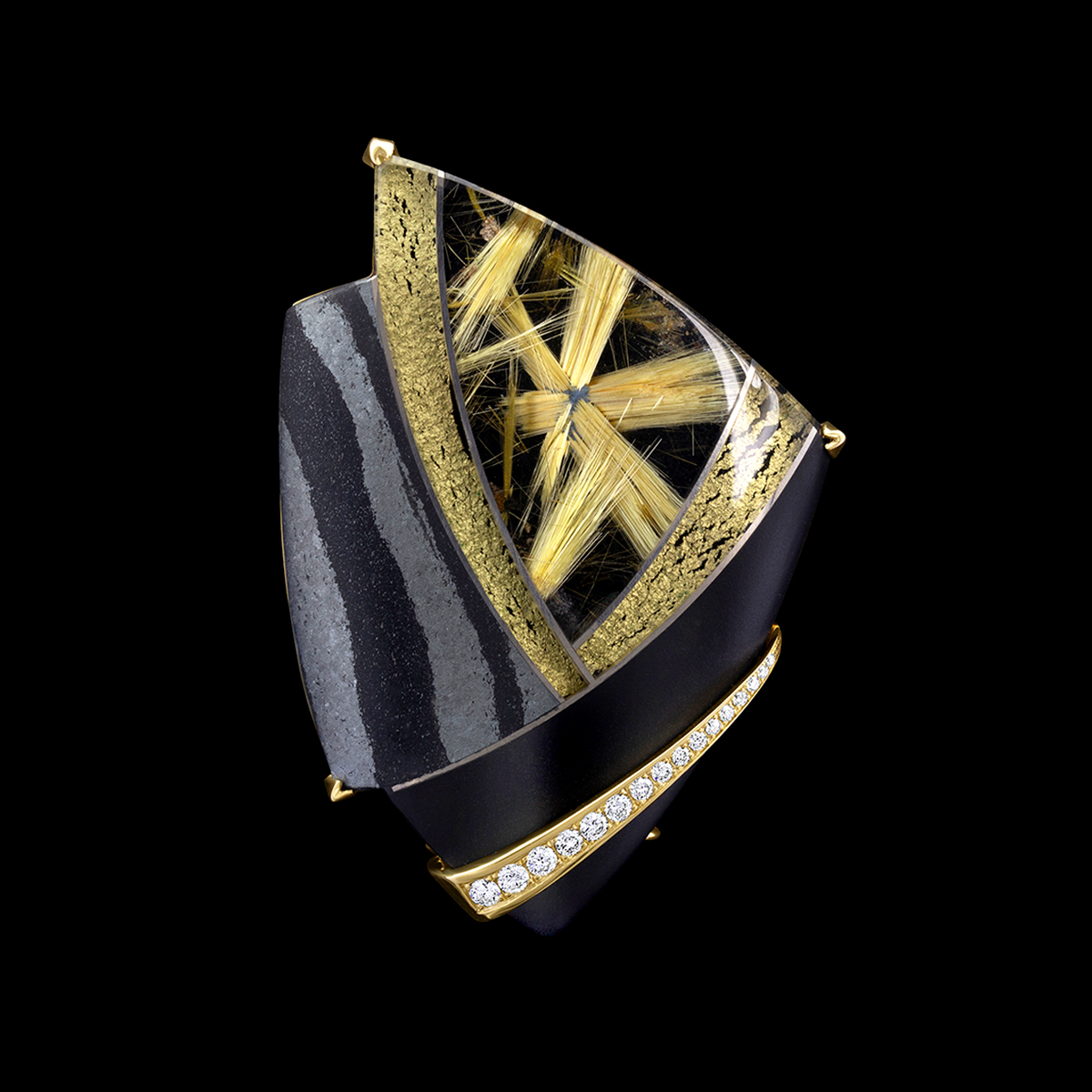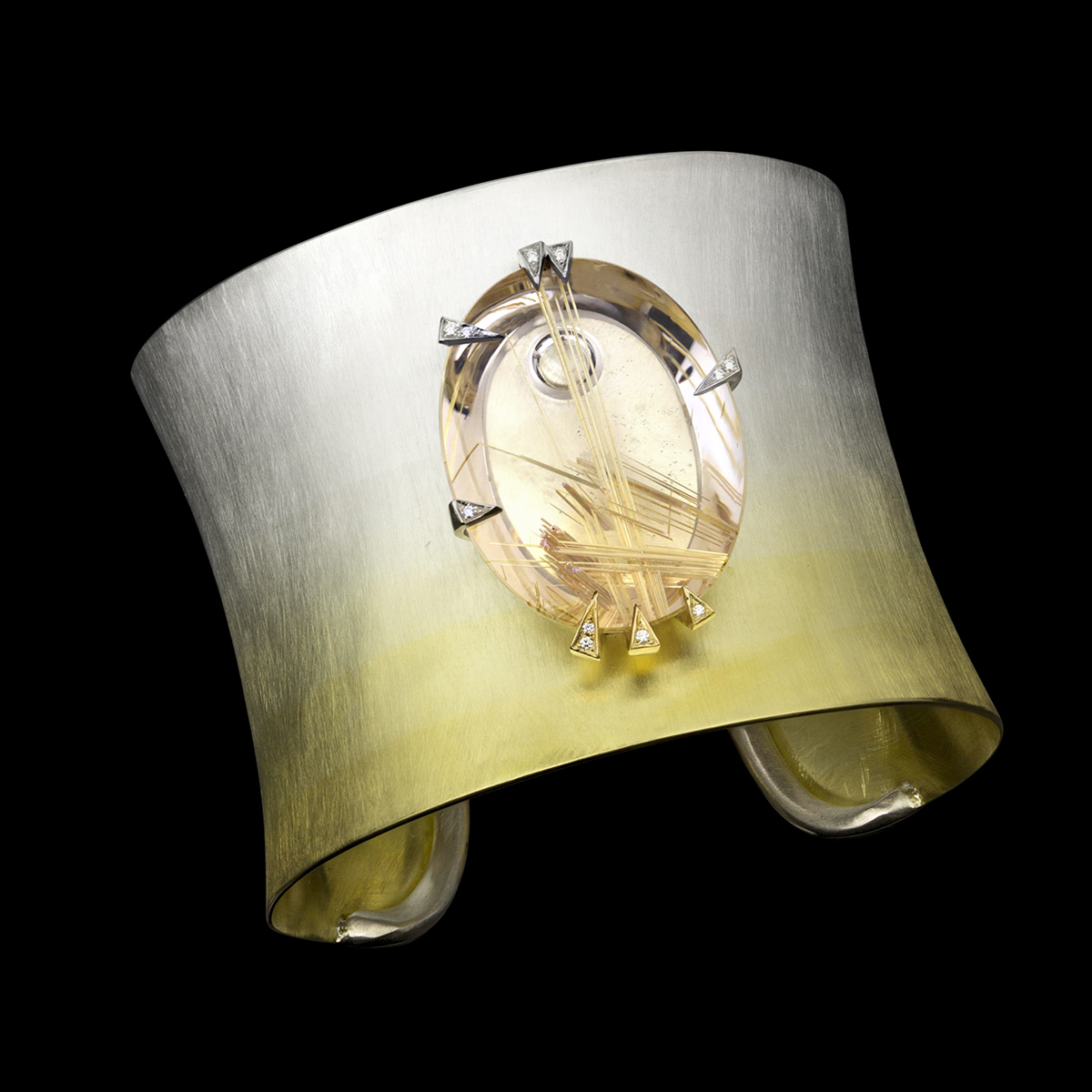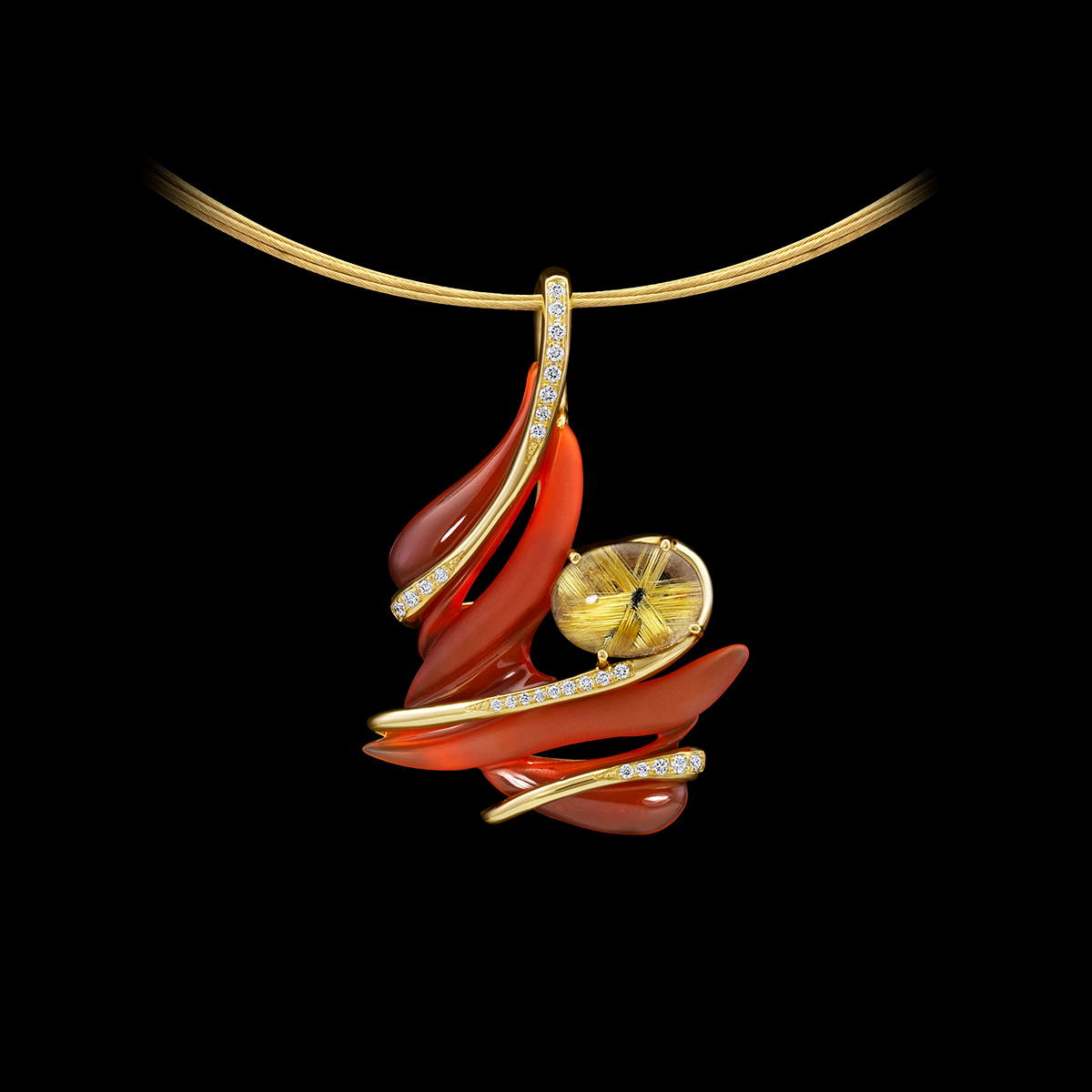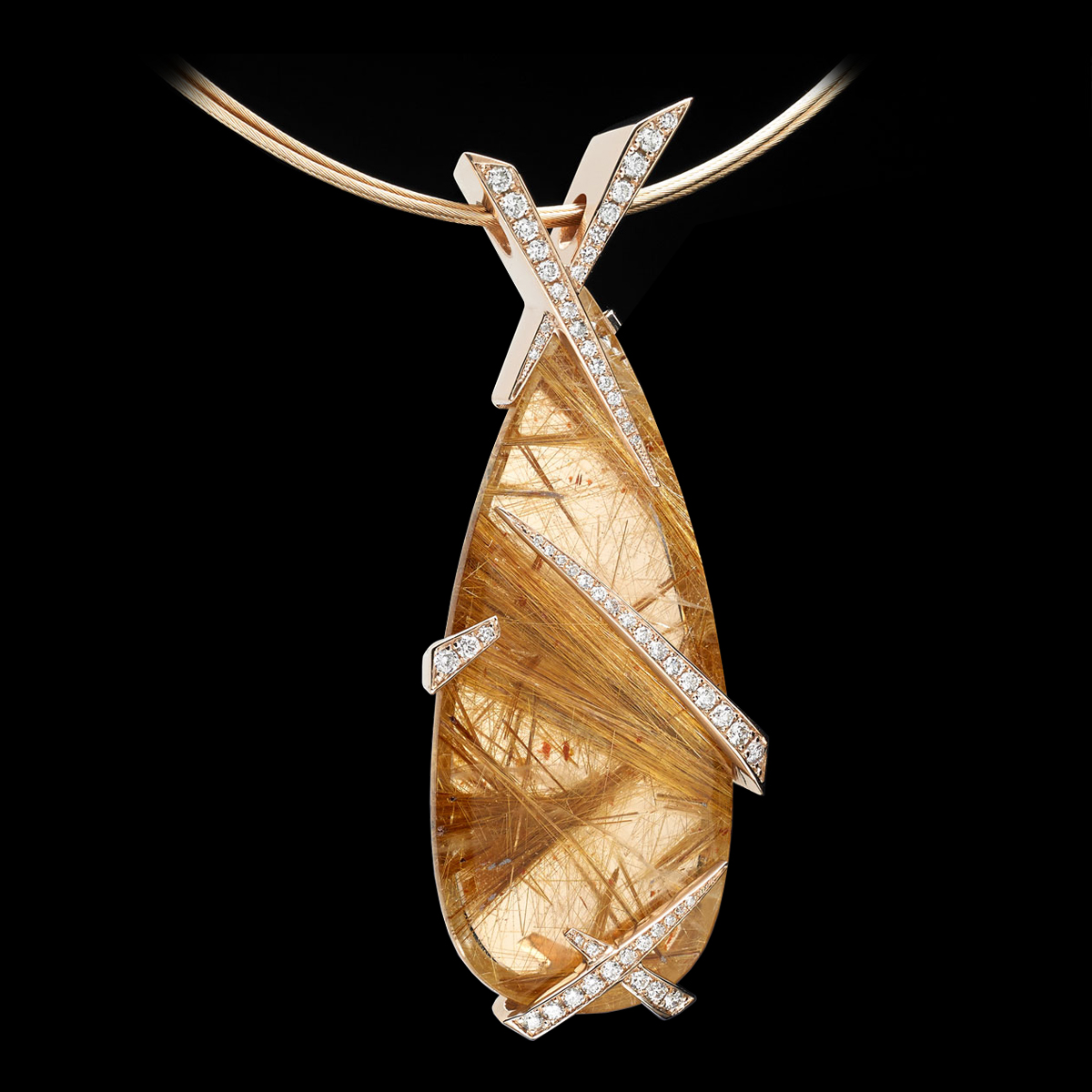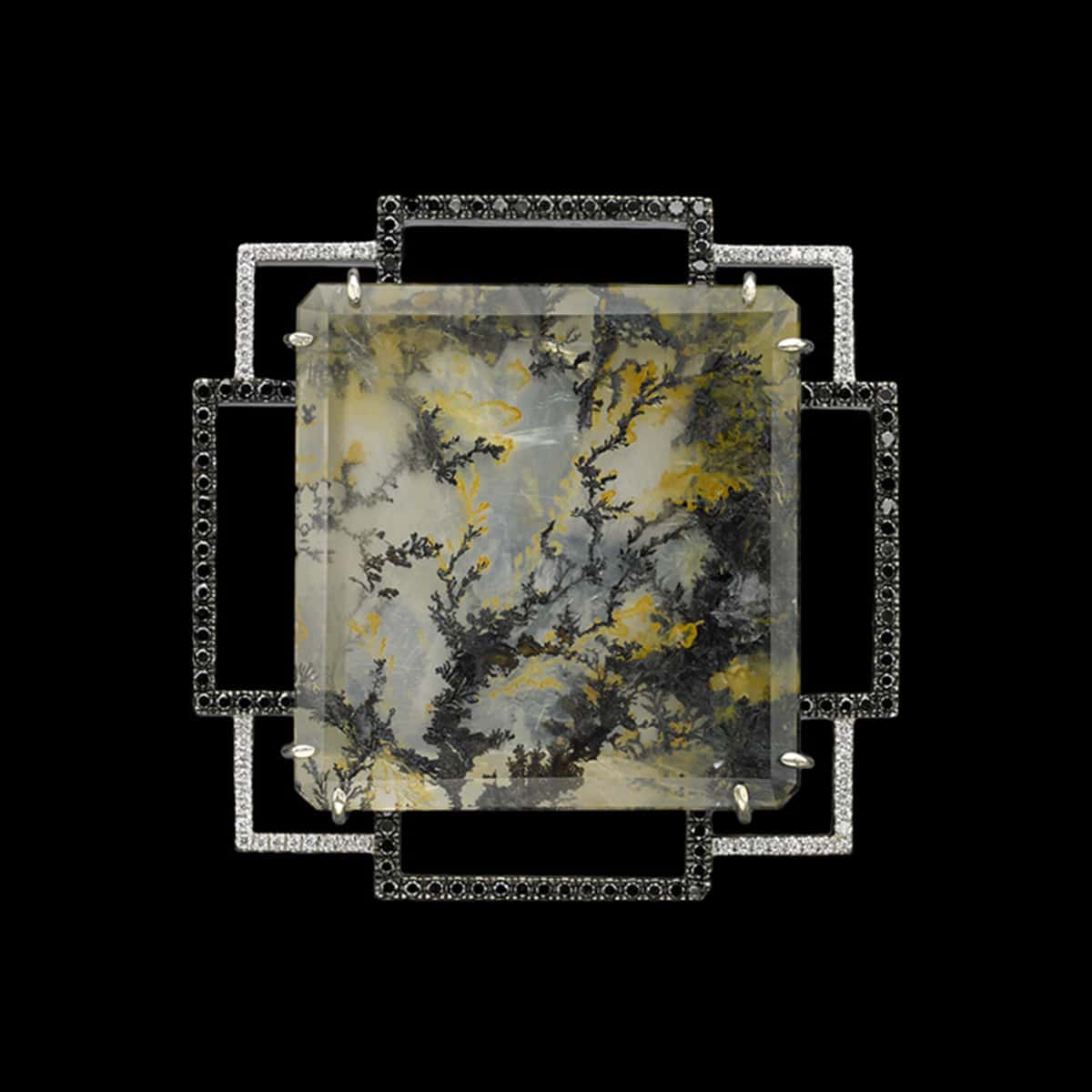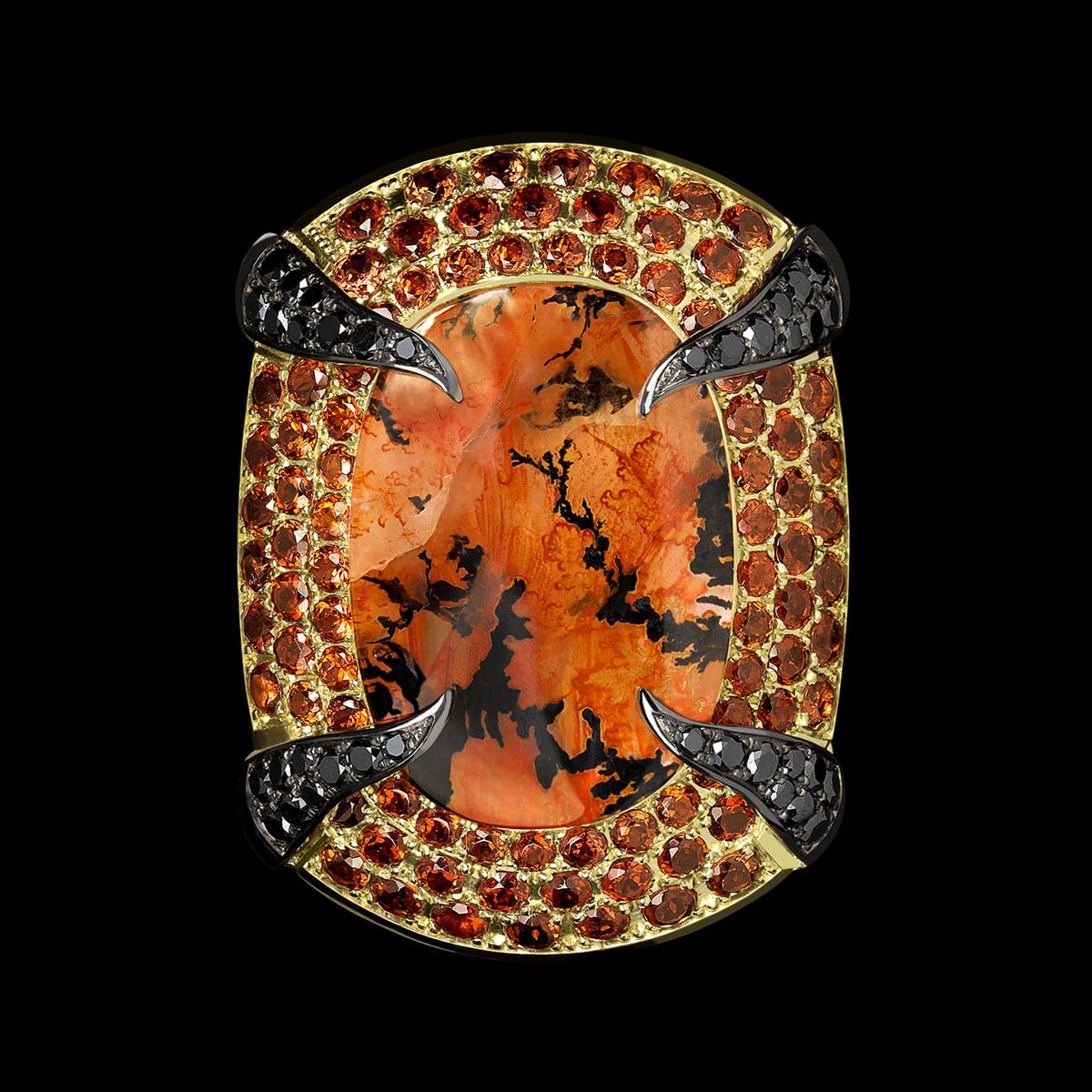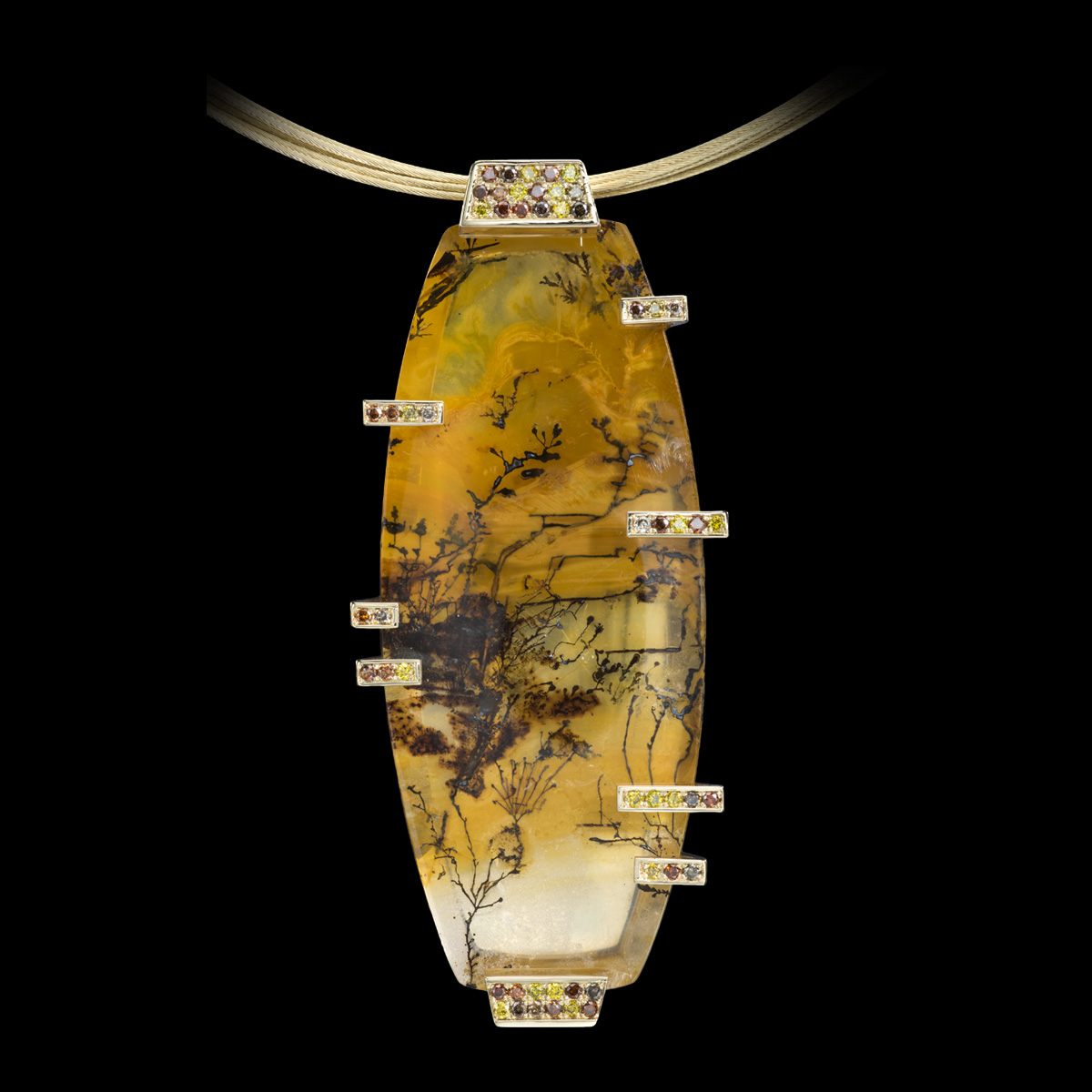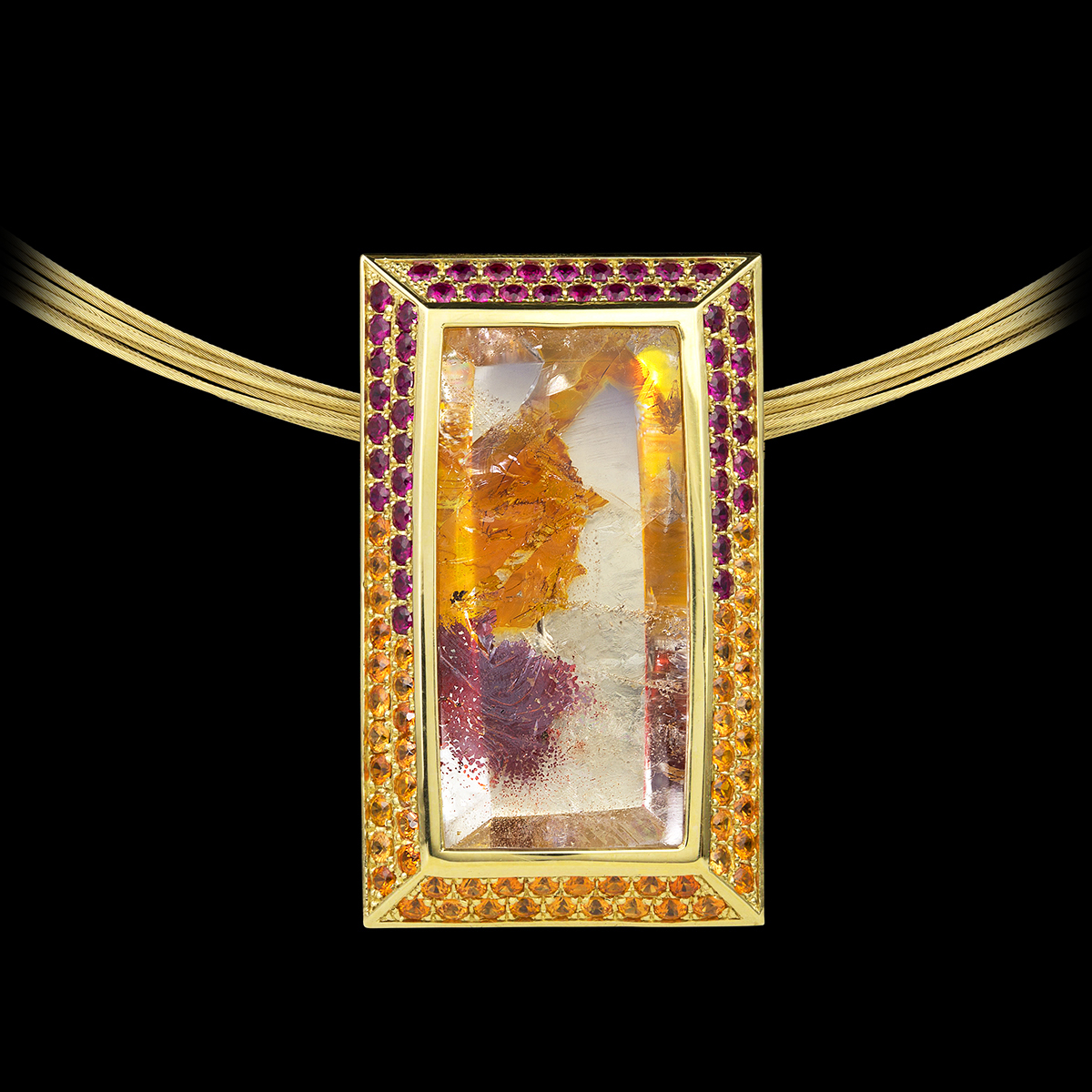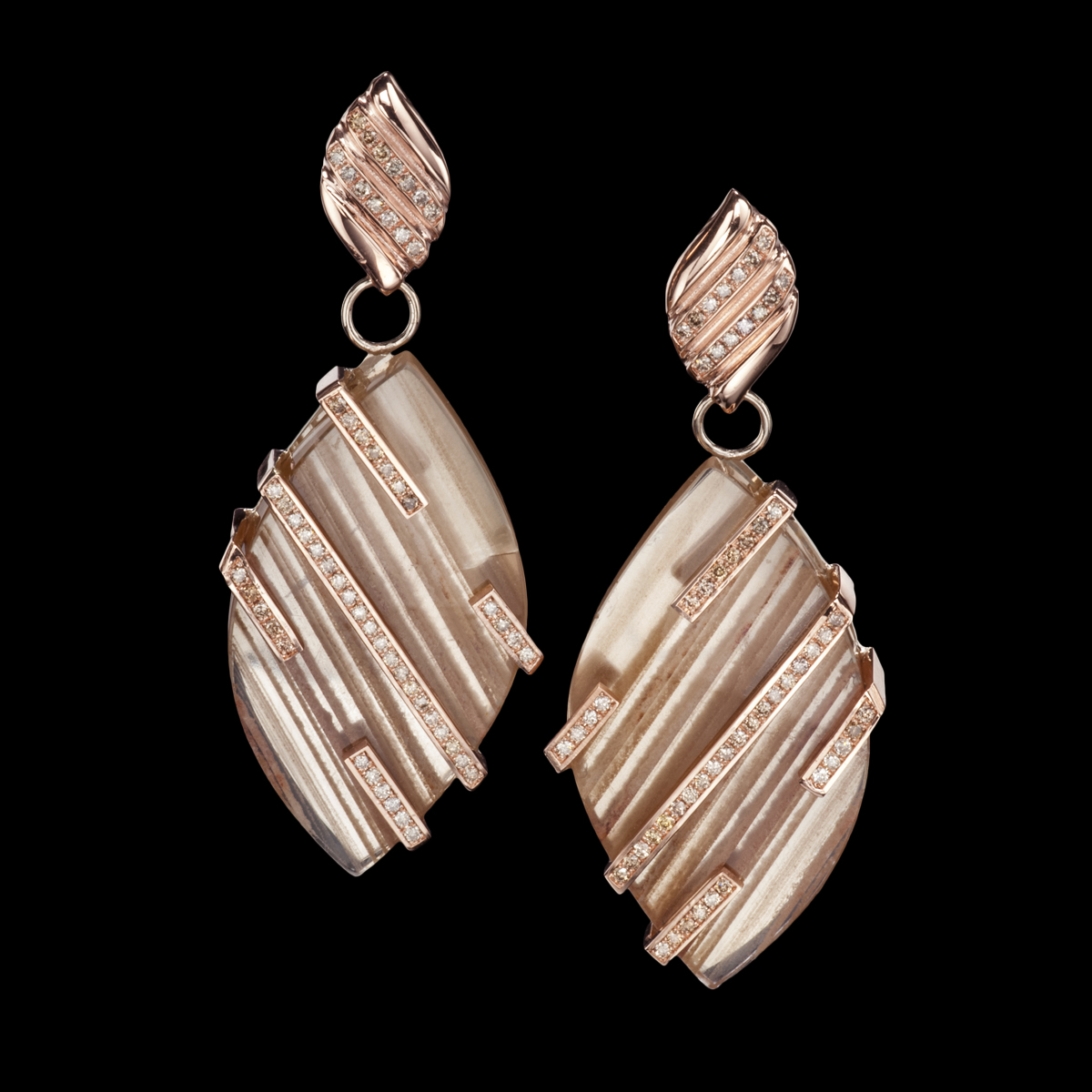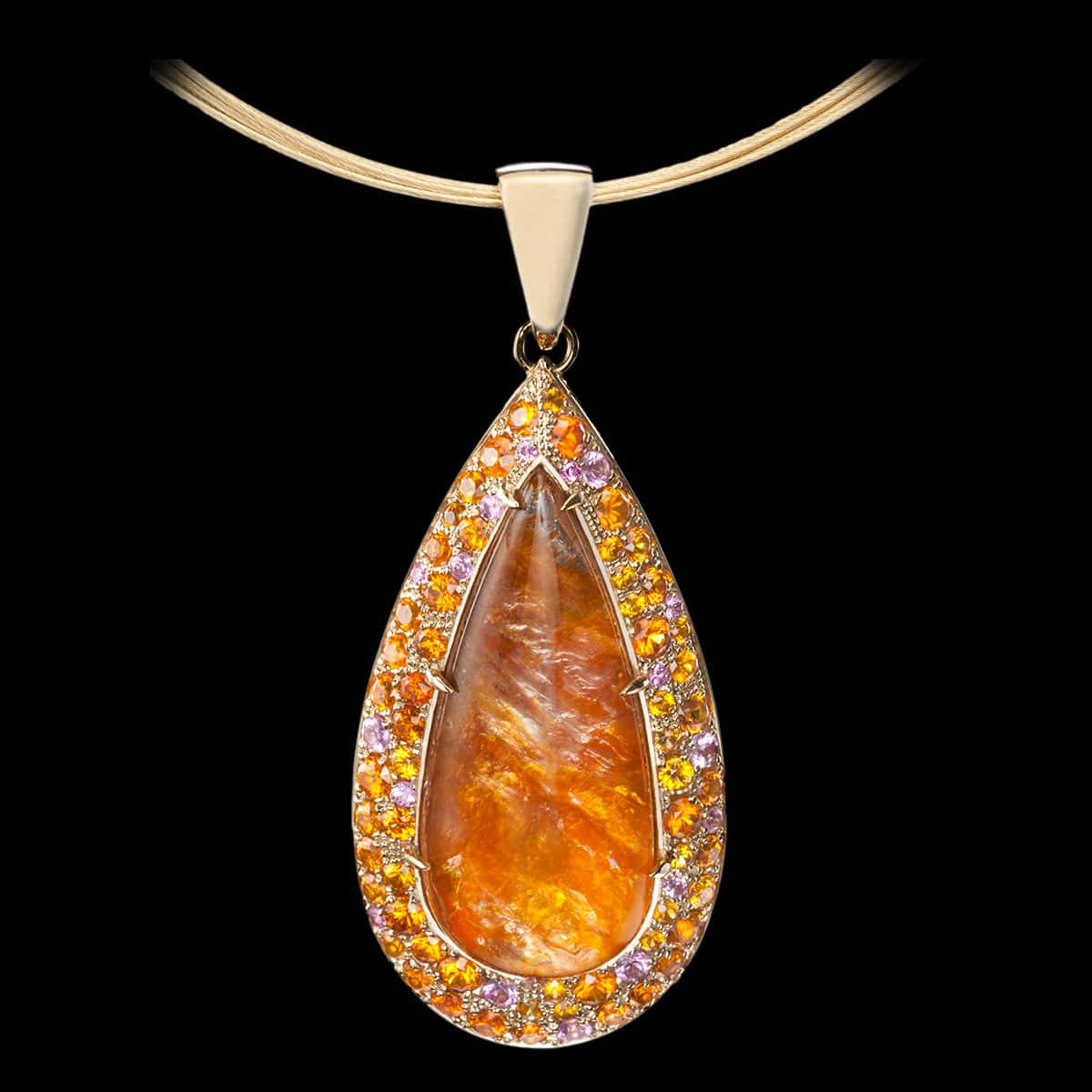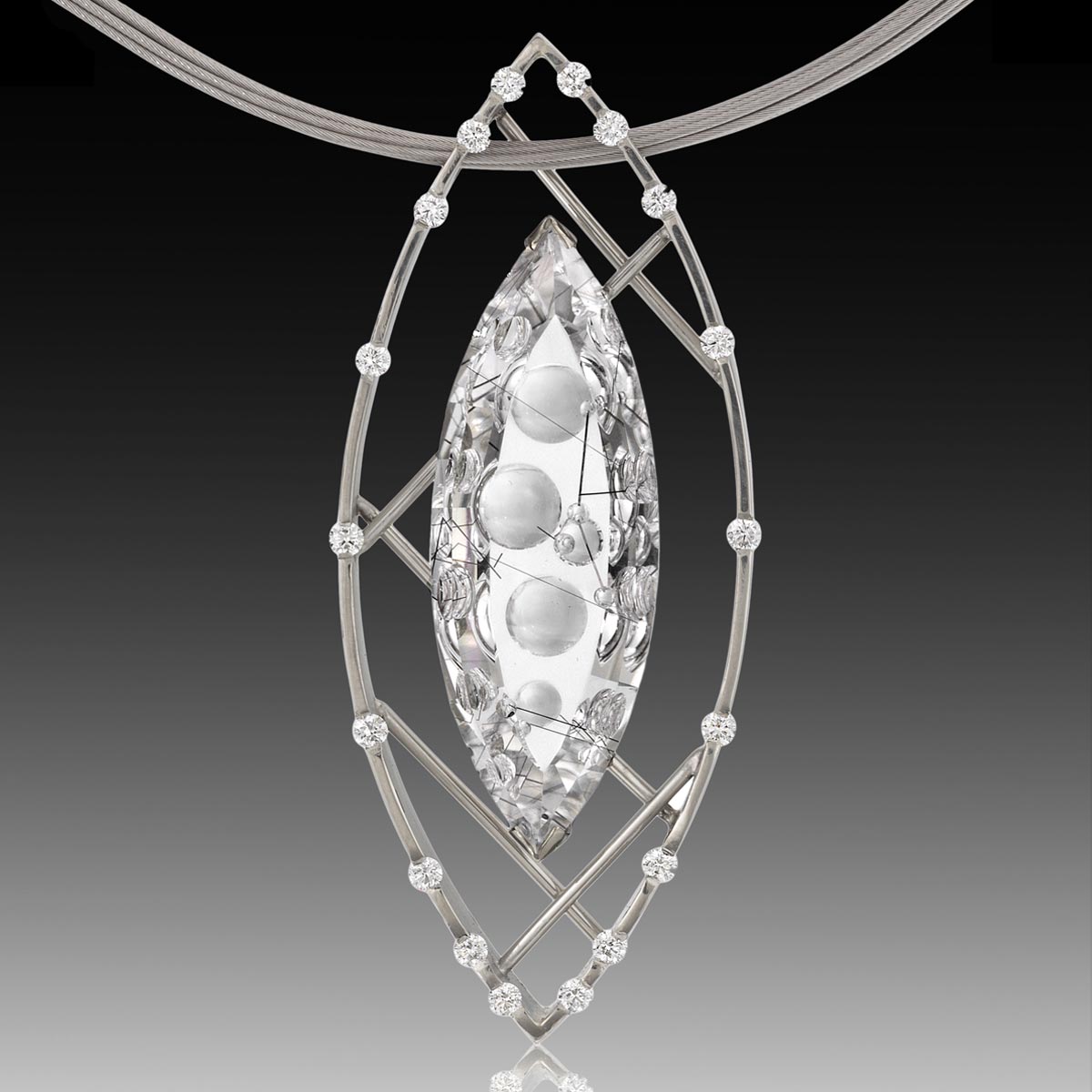Included Quartz: A Window Into the Past
Quartz inclusions open an exciting window into the past. From within the safety of quartz crystals, minerals, liquids, and gases are well-protected from chemical or physical changes. Included quartz may refer to a variety of gemstones containing a foreign mineral protected within a sturdy body of quartz. The beautiful patterns and colors of included quartz evoke images of nature and even the galaxy. These gardens, stars, or sunsets frozen in time offer a unique opportunity for jewelry designers to complement these scenes and showcase the artistry of nature itself.
About Quartz
Made up of oxygen and silicon, Quartz stands out as one of the most useful mineral resources on our planet. Chemically-stable, heat resistant, and highly durable, quartz holds up ruggedly against the elements. Owing to electrical conductivity, it is also valued for use in electronics. Many clear, colorful, and included examples of quartz are prized as gemstones. Citrine, Amethyst, Carnelian are all examples of colored quartz.
What are Inclusions?
An inclusion simply means an instance of some other material present within a mineral sample. When clear quartz contains other, foreign minerals, the specimen is called an included quartz. Typically inclusions denote lesser value for transparent gems. However, unique and beautiful inclusions in quartz can increase value.
Included Quartz: A Window Into the Past
Quartz inclusions open an exciting window into the past. From within the safety of quartz crystals, minerals, liquids, and gases are well-protected from chemical or physical changes. Included quartz may refer to a variety of gemstones containing a foreign mineral protected within a sturdy body of quartz. The beautiful patterns and colors of included quartz evoke images of nature and even the galaxy. These gardens, stars, or sunsets frozen in time offer a unique opportunity for jewelry designers to complement these scenes and showcase the artistry of nature itself.
About Quartz
Made up of oxygen and silicon, Quartz stands out as one of the most useful mineral resources on our planet. Chemically-stable, heat resistant, and highly durable, quartz holds up ruggedly against the elements. Owing to electrical conductivity, it is also valued for use in electronics. Many clear, colorful, and included examples of quartz are prized as gemstones. Citrine, Amethyst, Carnelian are all examples of colored quartz.
What are Inclusions
An inclusion simply means an instance of some other material present within a mineral sample. When clear quartz contains other, foreign minerals, the specimen is called an included quartz. Typically inclusions denote lesser value for transparent gems. However, unique and beautiful inclusions in quartz can increase value.
What’s special about Included Quartz
Included quartz is a dazzling exception to this tendency to value purity in gems. Formed when quartz and an accompanying mineral were super-heated to a molten state and then cooled together, quartz inclusions are a thing of beauty. In an included quartz, we can see minerals that would otherwise be chemically altered or dissolved in volatile geological conditions. Stable and sturdy quartz crystals protect and preserve many minerals in this way. Likewise, fragile minerals that are very soft, crumbly or that occur as fibers or thin needles survive erosion when embedded in quartz. In other cases, delicate minerals not completely embedded may dissolve over time but leave ghost-like hollow form within a quartz specimen. The appearance and value of an included quartz depend on its rarity and appearance.
What’s special about Included Quartz
Included quartz is a dazzling exception to this tendency to value purity in gems. Formed when quartz and an accompanying mineral were super-heated to a molten state and then cooled together, quartz inclusions are a thing of beauty. In an included quartz, we can see minerals that would otherwise be chemically altered or dissolved in volatile geological conditions. Stable and sturdy quartz crystals protect and preserve many minerals in this way. Likewise, fragile minerals that are very soft, crumbly or that occur as fibers or thin needles survive erosion when embedded in quartz. In other cases, delicate minerals not completely embedded may dissolve over time but leave ghost-like hollow form within a quartz specimen. The appearance and value of an included quartz depend on its rarity and appearance.
Rutilated Quartz
When shimmering rutile makes a home within the crystal structure of quartz, a beautiful and storied material results. Rutilated quartz, as it is called, displays intricate needle-like inclusions of rutile, or titanium dioxide, which occur in radiating patterns, like a firework at the moment of explosion. The effect is dramatic and each example of rutilated quartz holds a distinct and unique pattern.
Rutile is also responsible for the star-like light interaction, called asterism, which occurs in star sapphires and star rubies. Quartz is the harder of the pair of minerals, a 7 on the Mohs scale of hardness, as compared to the softer rutile with a hardness of 6. This discrepancy results in many examples of rutilated quartz with pitted and irregular surfaces. For this reason, examples of smooth, uniform quartz are especially desirable.
Folklore holds that rutilated quartz enhances creativity and individuality, improves interpersonal relationships, and slows the aging process. It has been found in many places around the globe including Brazil, Australia, Kazakhstan, Norway, Madagascar, Pakistan, and the United States.
Dendritic Quartz
Formed from a solution of manganese and iron, dendrites are a mineral crystallization with an uncanny resemblance to plant-life. These crystals would not normally be very robust, but with quartz all around these formations are well protected. Dendrite structures are dark may look like roots, trees, or ferns. Sometimes iron content will give the quartz specimen an orange, reddish, or golden color.
Chlorite, Hematite, and Iron Included Quartz
When quartz crystals surround and protect the minerals chlorite, hematite, and iron, the visual effect can be magical. Chlorite inclusions may appear green or sometimes pink in color. Inclusions may appear like a cloud of smoke, a mossy forest floor, or a mystical landscape. Hematite included quartz may show veins, sheets, or clouds of a red, pink, or orange inclusions. Iron included quartz displays rust-colored or pink inclusions within the clear quartz body. Both Hematite and Iron inclusions can appear to give a striking “painted effect”.
Tourmalinated Quartz (or Tourmaline Quartz)
Prized as a gemstone, tourmaline occurs naturally in a rainbow array of colors. When quartz and tourmaline get together, the result is striking. Specimens of tourmalinated quartz, also called tourmaline quartz, display black tourmaline, also known as schorl, embedded in milky or clear quartz. Owing to tourmaline’s crystal structure, the black mineral forms thin, rod or needle-like inclusions, creating a stunning visual contrast to the surrounding transparent crystal-body.
Tourmalinated Quartz is found around the world, with exceptional deposits in Minas Gerais, Brazil. Myth holds that this special gem can be worn as an amulet of spiritual protection. The belief is that this jewel bolsters its wearer to overcome the temptation of destructive behavior and keep a clear mind.
When quartz meets other minerals, the visual effect can be captivating gem-lovers and jewelers alike. Since each specimen is highly unique, included quartz is a playground for the imagination and rich with design inspiration.
We hope you’ve enjoyed this excursion into the world of included quartz. All jewelry shown in this article was designed and crafted by Adam Neeley. Please reach out to us about the work featured here or upcoming creations showcasing this fascinating gemstone.
Rutilated Quartz
When shimmering rutile makes a home within the crystal structure of quartz, a beautiful and storied material results. Rutilated quartz, as it is called, displays intricate needle-like inclusions of rutile, or titanium dioxide, which occur in radiating patterns, like a firework at the moment of explosion. The effect is dramatic and each example of rutilated quartz holds a distinct and unique pattern.
Rutile is also responsible for the star-like light interaction, called asterism, which occurs in star sapphires and star rubies. Quartz is the harder of the pair of minerals, a 7 on the Mohs scale of hardness, as compared to the softer rutile with a hardness of 6. This discrepancy results in many examples of rutilated quartz with pitted and irregular surfaces. For this reason, examples of smooth, uniform quartz are especially desirable.
Folklore holds that rutilated quartz enhances creativity and individuality, improves interpersonal relationships, and slows the aging process. It has been found in many places around the globe including Brazil, Australia, Kazakhstan, Norway, Madagascar, Pakistan, and the United States.
Dendritic Quartz
Formed from a solution of manganese and iron, dendrites are a mineral crystallization with an uncanny resemblance to plant-life. These crystals would not normally be very robust, but with quartz all around these formations are well protected. Dendrite structures are dark may look like roots, trees, or ferns. Sometimes iron content will give the quartz specimen an orange, reddish, or golden color.
Chlorite, Hematite, and Iron Included Quartz
When quartz crystals surround and protect the minerals chlorite, hematite, and iron, the visual effect can be magical. Chlorite inclusions may appear green or sometimes pink in color. Inclusions may appear like a cloud of smoke, a mossy forest floor, or a mystical landscape. Hematite included quartz may show veins, sheets, or clouds of a red, pink, or orange inclusions. Iron included quartz displays rust-colored or pink inclusions within the clear quartz body. Both Hematite and Iron inclusions can appear to give a striking “painted effect”.
Tourmalinated Quartz (or Tourmaline Quartz)
Prized as a gemstone, tourmaline occurs naturally in a rainbow array of colors. When quartz and tourmaline get together, the result is striking. Specimens of tourmalinated quartz, also called tourmaline quartz, display black tourmaline, also known as schorl, embedded in milky or clear quartz. Owing to tourmaline’s crystal structure, the black mineral forms thin, rod or needle-like inclusions, creating a stunning visual contrast to the surrounding transparent crystal-body.
Tourmalinated Quartz is found around the world, with exceptional deposits in Minas Gerais, Brazil. Myth holds that this special gem can be worn as an amulet of spiritual protection. The belief is that this jewel bolsters its wearer to overcome the temptation of destructive behavior and keep a clear mind.
When quartz meets other minerals, the visual effect can be captivating gem-lovers and jewelers alike. Since each specimen is highly unique, included quartz is a playground for the imagination and rich with design inspiration.
We hope you’ve enjoyed this excursion into the world of included quartz. Make one of these jewels a part of your jewelry collection or reach out to us with your gemstone questions.
Works Cited
Quartz Mineral | Photos, Uses, Properties, Pictures. https://geology.com/minerals/quartz.shtml. Accessed 14 Apr. 2020.
Tourmaline Quartz – Tourmalined Quartz – Tourmalinated. https://www.barlowsgems.net/new-tourmaline-quartz-cabochons/. Accessed 14 Apr. 2020.
Neeley, Adam. Personal interview. 13, April. 2020.
Available for Purchase – Included Quartz Designs
Works Cited
Quartz Mineral | Photos, Uses, Properties, Pictures. https://geology.com/minerals/quartz.shtml. Accessed 14 Apr. 2020.
Tourmaline Quartz – Tourmalined Quartz – Tourmalinated. https://www.barlowsgems.net/new-tourmaline-quartz-cabochons/. Accessed 14 Apr. 2020.
Neeley, Adam. Personal interview. 13, April. 2020.


